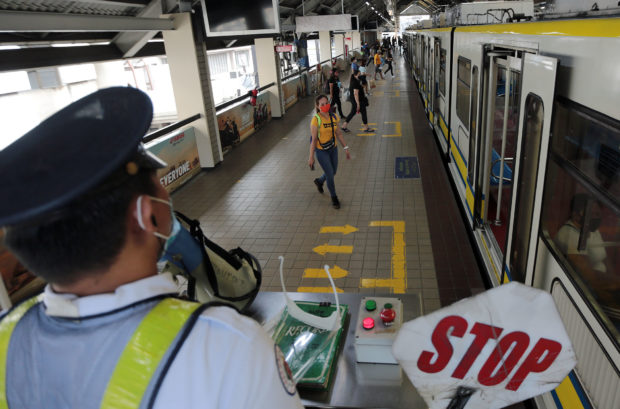
LRT LAY-OFF The Light Rail Transit Line 1 will be getting rid of around 20 percent of its work force following a drastic drop in ridership due to COVID-19. Based on data from the Department of Transportation, the train line served only 1.4 million passengers in a month. Before the pandemic struck, it used to ferry around 500,000 riders a day. —GRIG C. MONTEGRANDE
MANILA, Philippines — After recording a drastic drop in ridership due to the new coronavirus disease (COVID-19), the management of the Light Rail Transit (LRT) Line 1 announced on Tuesday that it would be terminating 100 employees, mostly technicians and tellers, effective on Sept. 15.
The number of personnel to be laid off, according to the Light Rail Manila Corp. (LRMC), the private consortium managing the train line, comprised about 20 percent of the LRT 1’s total workforce.
“For the rightsizing program, we took a look at the best size and shape of each team to match the level of operations and activity now,” LRMC corporate communications head Jacqueline Gorospe told the Inquirer.She said that most of the affected personnel were tellers and technicians, including those who had volunteered to retire.
According to the LRMC, the LRT 1’s ridership has dropped by 90 percent since the pandemic hit the country as all train lines, based on guidelines issued by transportation authorities, can carry only less than 15 percent of their normal capacity.
Based on the Department of Transportation’s last update in June, the LRT 1’s ridership for an entire month was 1,397,546. In comparison, it served up to 500,000 passengers a day before COVID-19 struck.
No operations
The LRT 1 suspended operations from March 17 to May 31 after Luzon was placed on lockdown, resulting in a ban on all forms of public transport. Along with other train lines, it reopened on June 1 but shut down again on Aug. 4 after Metro Manila went back under modified enhanced community quarantine. The LRMC made the announcement a week before the metropolis was expected to revert to laxer quarantine restrictions which would mean the lifting of the ban on public transport.
In a public statement, the LRMC said that while it “has scaled down operations during the quarantine period and deferred some projects, the company recognizes the need to optimize human resources by reducing the size of the workforce.”“The decision went through multiple levels of approvals involving the LRMC senior management committee, in close consultation with LRMC’s employee unions,” it added.
The company assured the public that all terminated employees would receive their dues as stipulated by labor laws and under their collective bargaining agreement with LRMC.
Biggest train line
Of the four train lines in the National Capital Region, only the LRT 1—which traverses Parañaque to Caloocan—has been privately operated and managed since 2015, when LRMC bagged the concessionaire agreement for the biggest train line in Manila. It is also the only railway to announce a lay-off of employees so far.
Gorospe said she could not disclose their net losses since the pandemic struck the Philippines.
“Business experts foresee that most companies will recover their pre-COVID-19 status only by 2022,” she said. “So in LRMC’s case, the reduced size will be as is for now. But we are not totally closing our doors to the possibility (of rehiring those who have been laid off) or how business will evolve in the next few months or years.” INQ